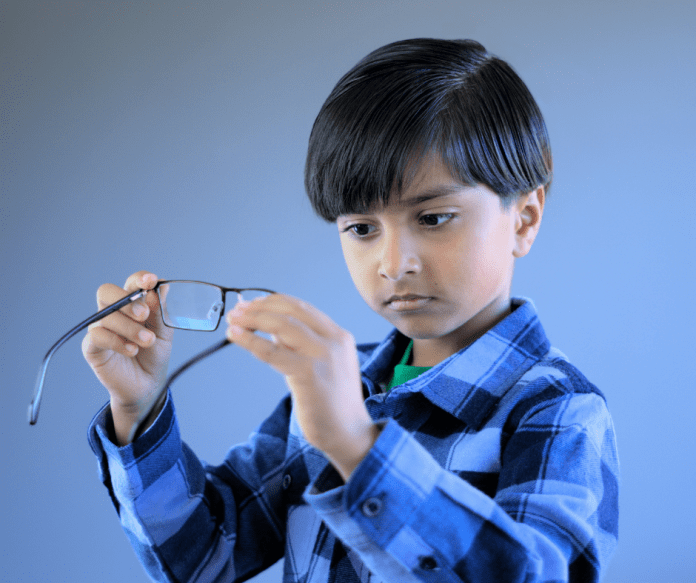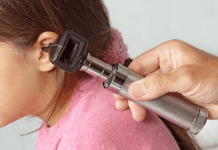I recently had the opportunity to chat with Dr. Casey Mickler about pediatric eye health. What I expected to be an informative overview turned into a fascinating discussion about the advances in technology and research taking place in pediatric ophthalmology today. Pensacola is so fortunate to have an excellent resource in Dr. Mickler at Studer Family Children’s Hospital at Ascension Sacred Heart. I hope our conversation is helpful to you in caring for and protecting your child’s vision.
Vision Screening: The Where, When, and How
Your pediatrician’s office should have photo-vision screening equipment. This technology is a significant and relatively recent break-through in pediatric vision screening. Before the photo-vision screening, doctors had to wait until a child was both verbal and aware enough of their vision to let a parent know that something was off. If you have ever attempted a rational conversation with a toddler, then you can understand why this was a challenge in early detection. Now, pediatricians can start screening for potential issues as early as your child’s one-year well visit.
We have had both our children screened, and it was indeed the easiest and quickest part of the visit. The whole process takes the same time as a bright photo flash. That flash produces a picture of your child’s eyes that will show your pediatrician any indication of an Amblyopia Risk Factor. An indication of a risk factor does not necessarily mean there is a problem, but simply that another look is worthwhile. Your pediatrician may recommend waiting to do another screening in a few months or give you a referral for a pediatric ophthalmologist.
The Why: “You See With Your Brain, Not With Your Eyes”
Early detection of risk factors is important because Amblyopia is an irreversible condition. Your child may have normal eyes, but with Amblyopia, the brain processes one eye’s image more clearly than the other. When that happens, the brain starts to turn off the image it doesn’t like, and after a while, there is no way to get the brain to turn it back on. This could lead to a range of issues- maybe just mild vision loss like 20/40 vision (still legal to drive a car), but in the worst cases, it can lead to blindness. Glasses don’t fix the issue since it is not a structural problem with the eye. The good news is that when risk factors for Amblyopia are detected early, ophthalmologists can work with your child to keep the brain from turning an image off.
Going to the Ophthalmologist: What to Expect
Before we had a referral to Dr. Mickler, I had no clue that pediatric ophthalmologists existed. Dr. Mickler completed his residency specializing in pediatric ophthalmology and has spent his career working with children. Most Ophthalmologists have equipment and procedures tailored to adults. While all of the exams are meant to accomplish the same goal, having chairs, goggles, and personalities geared toward kids can make a big difference in the doctor’s ability to identify (or rule out) any potential problems.
One thing Dr. Mickler told me, that in hindsight seems so obvious, is that the biggest challenge in a child’s initial appointment is the eye drops. Kids HATE them (as do most adults if we’re honest!). You know your child best, so if a trial run with fake tears will help your kiddo get used to the idea, think about doing that a day or two before the appointment. While getting eye drops in is typically a frustration, for some children, it can be a traumatic event.
Your doctor will rely on you to be a partner in treating your child, so helping your child understand what’s happening will help them more successfully assess your child.
“You Can See a Lot By Just Looking”
This is Dr. Mickler’s ophthalmologist version of the famous quote by Yogi Berra, “You can observe a lot by just watching.” Ophthalmologists spend their days looking at eyes and have a different ability to recognize patterns in eye structure, etc. that allow them to figure out what is going on with your child’s vision.
Your doctor will check three main components:
- Is the physical organ healthy?
- Does the eye lens system work? This is the refraction portion: think the side view of the eyeball with the triangle of light coming in from 9th-grade Biology.
- Does the motor system work? Think tracking and alignment of the eyeball (crossed eyes or drifted eyes).
Depending on what your doctor finds, they may not recommend treatment. In that case, Dr. Mickler stressed that you don’t need to worry about taking your child to an eye doctor annually. Your pediatrician will continue the photo-screening vision tests at well-checks, so you will know if an issue arises down the road.
If your doctor finds a high-risk factor, they may recommend treatment such as glasses or continued observation. If there is a borderline risk factor, they will likely want to see your child again in 6 months or a year.
Glasses! Now What?
Dr. Mickler stressed that you, as the parent, will set the tone for your child’s success with glasses. He made the comparison that instructing your child to wear their glasses needs to have the urgency you use to tell them not to run into the street, instead of the tone you use to tell them not to get another snack out of the pantry. Wearing glasses needs to be non-negotiable. You may beat your head against the wall some days but stopping long-term damage to your child’s vision is worth that fight.
My husband’s brother wore glasses that he says, “were so thick you could see the future and the past through them.” Fortunately, glasses and the stigma around them have come a long way since the 1980s. More kids are wearing glasses at an early age (more on that in a minute), so chances are your child will not be the only one in their class or group of friends. There are options from indestructible sports goggles to sparkly fun glasses to fit your child and their activity level.
Here Comes the Sun
When I discussed the wide variety of children’s glasses with Dr. Mickler, I asked him if the seemingly larger number of children wearing glasses today was due to earlier screening and detection. I assumed he would give me the feel-good answer of “absolutely!” However, the answer is far more complicated. Yes, kids are wearing glasses more often due to doctors being able to catch issues earlier. BUT…the incidence rate of refractive issues is skyrocketing. Myopia, or near-sightedness, has reached an epidemic level (greater than 50%) in some Asian countries. In the United States, more than 25% of the population experiences near-sightedness.
Most of the research done on this topic points to sunlight- or the lack thereof- as the main factor in ocular health. Kids today have significantly less exposure to sunlight than they did even ten or twenty years ago, which is contributing directly to the high rate of near-sightedness in today’s children.
Scientists have found that an average of two hours of sunlight per day is critical to the eye’s health. Exposure to sunlight can be as mild as sitting under a tree on a cloudy day, but it is a must. Ideally, your child will get this exposure as preventative care before any issues arise. But even after an issue is detected, sunlight can help slow any deterioration. Getting outside also forces your child to use their distance vision, whether watching clouds or a soccer ball across the field, they will be focusing differently than they do when looking at a computer up close.
The other mind-blower that Dr. Mickler explained is that sunglasses are great if they help your child with comfort, but their eyes will be fine without them! He did stress that if your child would like to wear sunglasses, make sure they have UV protection. Long story short, our parents were right about everything, and getting our children outside for fresh air and sunlight truly does keep them healthier.










